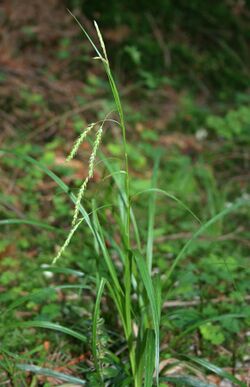Biology:Carex sylvatica
| Carex sylvatica | |
|---|---|

| |
| Scientific classification | |
| Kingdom: | Plantae |
| Clade: | Tracheophytes |
| Clade: | Angiosperms |
| Clade: | Monocots |
| Clade: | Commelinids |
| Order: | Poales |
| Family: | Cyperaceae |
| Genus: | Carex |
| Species: | C. sylvatica
|
| Binomial name | |
| Carex sylvatica Huds. [1]
| |
Carex sylvatica is a species of sedge found in deciduous woodlands across Europe. It typically reaches 60 cm (24 in) tall, and has an inflorescence made up of 3–5 pendent female spikes and a single male spike. It is also used as a garden plant, and has been introduced to North America and New Zealand.
Description
Carex sylvatica "resembles a small C. pendula",[2] growing to around 15–60 centimetres (6–24 in) tall, or up to 150 cm (5 ft) in exceptional cases.[1] Its rhizomes are very short, giving the plant a densely cespitose (tufted) form.[1][3] The leaves are 5–60 cm (2.0–23.6 in) long, 3–7 mm (0.12–0.28 in) wide[1] and 1.0–1.3 mm (0.04–0.05 in) thick,[3] with 17–31 parallel veins. The leaves have a slight keel, or are folded gently into an M-shape in cross-section.[1]
The top half or third of the stem bears the inflorescence, typically comprising 3–5 female spikes and a single apical male spike,[1] which may include a few female flowers at its base.[3] The female spikes are each 2.0–6.5 cm (0.8–2.6 in) long, and are held dangling on long, rough peduncles, arising from within a long leaf-sheath.[1] The male spike is much thinner, and is 1–4 cm (0.4–1.6 in) long.[1]
Taxonomy
Carex sylvatica was first described by the English botanist William Hudson in his 1762 work Flora Anglica.[4] Hybrids have been reported between C. sylvatica and C. strigosa (in France) and between C. sylvatica and C. hirta (in Austria).[3] Its English common name is "wood-sedge",[1] or, in North America, "European woodland sedge".[3]
Distribution and ecology
Carex sylvatica is found across Europe, and into parts of Asia, as far east as Iran.[5] It has also been introduced to North America, where it occurs in Ontario, New York and North Carolina, and to New Zealand,[3] where it was first recorded in 1969.[6]
In its native range, C. sylvatica lives in deciduous woodlands on heavy soils; it is sometimes found in unwooded areas, but usually only as a relic of ancient woodland.[1] In North America, it is generally found in disturbed areas within deciduous woodland.[3]
Uses
Carex sylvatica can be used in gardens as ground cover under trees or shrubs.[2] Carl Linnaeus recorded that the Sami people used the plant as an insulating wadding.[7]
References
- ↑ 1.0 1.1 1.2 1.3 1.4 1.5 1.6 1.7 1.8 1.9 A. C. Jermy; D. A. Simpson; M. J. Y. Foley; M. S. Porter (2007). "Carex sylvatica Huds.". Sedges of the British Isles. BSBI Handbook No. 1 (3rd ed.). Botanical Society of the British Isles. pp. 334–336. ISBN 978-0-901158-35-2.
- ↑ 2.0 2.1 Michael King; Piet Oudolf (1998). Gardening with Grasses. Frances Lincoln. p. 124. ISBN 9780711212022. https://books.google.com/books?id=-sIWitbvyDoC&pg=PA124.
- ↑ 3.0 3.1 3.2 3.3 3.4 3.5 3.6 Joy Mastrogiuseppe; Paul E. Rothrock; A. C. Dibble; A. A. Reznicek (2002). "Carex sylvatica Hudson, Fl. Angl. 353. 1762". Magnoliophyta: Commelinidae (in part): Cyperaceae. Flora of North America North of Mexico. 23. Oxford University Press. ISBN 978-0-19-515207-4. http://www.efloras.org/florataxon.aspx?flora_id=1&taxon_id=242357574.
- ↑ William Hudson (1762). "Carex" (in Latin). Flora Anglica. Londini, impensis auctoris. pp. 346–354. https://archive.org/stream/gulielmihudsoni01hudsgoog#page/n374/mode/2up.
- ↑ "Carex sylvatica". eMonocot. http://zoo-bclark01.zoo.ox.ac.uk/taxon/urn:kew.org:wcs:taxon:231389. Retrieved May 11, 2013.
- ↑ "Carex sylvatica". Flora. New Zealand Plant Conservation Network. http://www.nzpcn.org.nz/flora_details.aspx?ID=3619. Retrieved May 11, 2013.
- ↑ James Sowerby (1802). English botany. 14. London: J. Davis. https://books.google.com/books?id=pEEPAAAAYAAJ&pg=RA4-PA995.
External links
- Marek Nowicki, Radosław Walkowiak, Carex sylvatica, Pieniny National Park (Slovakia), CTC, 2019
Wikidata ☰ Q158168 entry
 |

